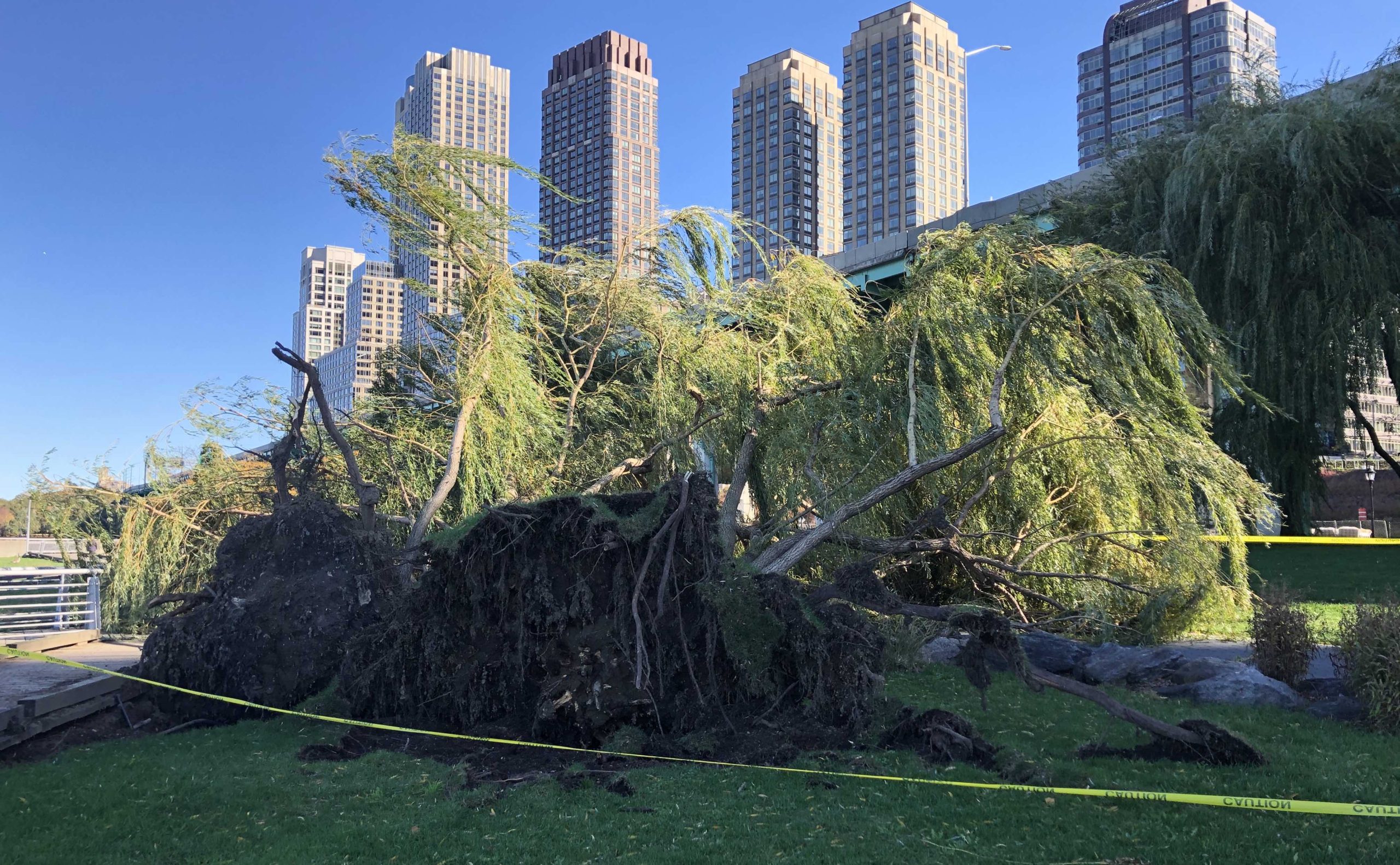I’ve been thinking a lot about water recently. My last Shoots! issue featured Gate 5, which has developed an innovative technology to transform sewage into renewable energy.
Since writing the last issue, weather-related events have kept water top of my mind. Last month, 1 inch of rain fell in New York City in a 24-hour period. This happens 20 or so times a year; unusual but not rare. What made this rain remarkable was it all fell in less than 15 minutes! Wind gusts upended planters on our balcony, spilling soil everywhere. A muddy mix of potting soil and gallons of water overwhelmed the large drain on our balcony.
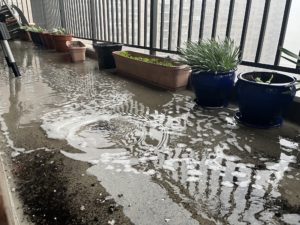
15 minutes of rain can cause significant flooding in urban areas!
Then the clouds dissipated, and the sun re-emerged. The storm came and went so quickly that many lucky subway commuters missed the entire deluge and were surprised to encounter drenched New Yorkers upon exiting the station. But the weather’s impact was substantial. Later that afternoon I saw countless downed tree branches and large standing puddles of water. Workers were still unclogging storm drains in Central Park three days later.
How many “once in a decade” weather events have you witnessed in the past year? Does it seem like you are encountering flooding more frequently?
We are not alone. Our communities are becoming less climate resilient. Read more to see how one person saw an opportunity to leverage technology to connect municipalities, community organizations, and individual property owners to begin to address climate-driven environmental damage.
THE PROBLEM
This was the second major flooding event I experienced firsthand in recent months. When I was in Hawaii shortly before the New Year, a normally small stream nearly washed out a bridge located near my childhood home. This never happened during my youth, even though the valley I grew up has always been rainy.
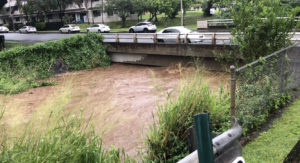
Near-catastrophic flooding in Manoa Valley in Honolulu
More frequent flooding is happening for two main reasons. First, our climate is becoming more severe. The rainstorm in Hawaii lasted for 24 hours. It was then followed by nearly two months of no rain. This past winter, New Yorkers experienced multiple two-day roundtrip swings between bone-chilling freezes and springlike temperatures. This is half of the picture.
In recent decades, humans have aggressively altered the landscape while the weather has become more erratic. When I first moved to my neighborhood in Hawaii, a dirt road ran behind my house, surrounded by trees and wild grass. Someone even kept horses! Today, buildings, roads, and sidewalks have replaced the greenery. Following the New York storm, much of the required cleanup focused on replacing soil from non-native landscaping, which is more prone to flooding and erosion.
Taken together, the more violent storms and the less forgiving terrain create a vicious cycle. The land can’t absorb the stormwater and filter it naturally underground. Instead, it’s repelled off rooftops and pavement, picking up soil, trash, and other pollutants along the way. Decades-old drainage systems cannot handle the increased rainfall volume. This cycle of long dry spells, large bouts of rain, flooding, and erosion persist. How can this be stopped?
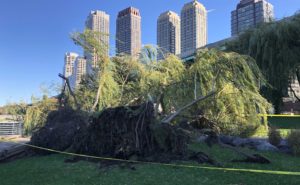
A downed (non-native) willow tree in New York City’s Riverside Park
RESPONDING TO A CLIENT CHALLENGE
Lauren Roth Venu is the founder and president of Roth Ecological Design International, a Honolulu-based water planning and green infrastructure design firm. She helps clients around the world adapt to climate change through onsite water management practices. Her clients have spanned from developers to public sector. Each client seeks solutions to manage stormwater onsite as well as support water conservation measures.
Looking deeper into the problem, Lauren recognized she was perfectly situated to solve these water challenges both locally and scale a solution globally. She created a separate company, 3Rwater (Reduce, Reuse, Recharge – e.g., placing rainwater into the ground) to pursue this.
Solving climate resiliency is complicated:
- It’s hard to even begin to describe the problem
- There are multiple parties – individual residents, commercial property owners, government agencies and municipalities
- Each sees a separate stage of the problem and have different motivations and resources
- Not everyone is capable of using technology
- Relevant data is available but is not analyzed holistically to find insight
- Accessing solutions can be costly and confusing
- Solutions like redirecting drainage and rain gardens are not well known
- It’s hard to see how a single person can have an impact on such a large problem
THE SOLUTION
3Rwater is addressing this challenge on several fronts:
Leverage user-friendly technology: 3Rwater’s solution begins with their easy-to-use app called Follow the Drop. This equips the end user – the resident, property manager or contractor – to collect the relevant information, including location and dimensions of the areas where stormwater needs to be managed.
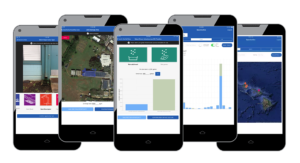
The Follow the Drop app is simple to use, yet is powerful in its insight and impact
Use readily available data: Once the property location and its square footage is known, Follow the Drop connects to local rainfall gauge networks and notifies the user of rainfall totals for its location.
Recommend solutions: Follow the Drop suggests potential stormwater capture solutions and where to place them. Where the city or utility offers an incentive program, the app displays the credit or rebate available based on the size and type of solution entered.
Easy Submission to municipalities/utility: Projects can be saved or submitted directly through the app to the municipality or utility where they can be reviewed and approved for user to receive the incentive offered.
Add value to municipalities: Beyond property dimensions and location, Follow the Drop equips property owners and contractors to capture and upload digital images on their own. Municipalities can verify stormwater capture system installation and ongoing maintenance without adding headcount.
Streamline record-keeping and processing: Municipalities with paper-based programs can eliminate storing and maintaining paper applications and records. Cities setting up brand-new programs can leapfrog straight to the cloud. Maintenance check reminders can be automated.
Interactive Dashboard: Just like energy utility apps that help residents to track their energy use, Follow the Drop has a dashboard function to allow both property owners and municipalities to track volumes of stormwater captured, money saved and view cumulative progress towards meeting community-wide stormwater management goals.
Use community organizations to drive impact: Even with app-based technology, it’s impossible to go house-to-house to drive adoption. 3Rwater is partnering with Malama Maunalua – a non-profit focused on restoring East Honolulu’s shoreline and reefs to conduct free rainwater assessments for homeowners. 3Rwater and another community partner, Kupu, also built a Follow the Drop curriculum. This curriculum empowers students from Grades 4 to 12 to survey their campus and identify opportunities to capture, store, and reuse their stormwater using a rain garden or rain catchment system.
PROGRESS
Lauren is building her presence beyond the City and County of Honolulu. She also is partnering with the City of Auckland to use the 3Rwater’s technology, with other plans to expand to the continental United States and beyond.
Forward-looking organizations are also recognizing the potential of 3Rwater. In 2021, 3Rwater was accepted into Cohort 12 for Blue Startups, a Hawaii-based startup accelerator. 3Rwater was also part of the WEFTEC21 Innovation Pavilion in Chicago and was one of a handful of companies selected by BlueTech Research to be in the Innovation Pavilion at WEFTEC, the water industries largest event in the U.S. Registrants of the conference voted 3Rwater the People’s Choice Award that gave 3Rwater the prize of another complimentary booth at the Innovation Pavilion at WEFTEC22 in New Orleans.
Lauren provides a great example how one person can play a role in addressing a global crisis, while also engaging different entities to get involved – municipalities, non-profits, schools, and property owners. Separately, each may feel they can’t make a difference themselves or lack the know-how or expertise to even begin. But technology can enable these parties to connect! By working together – collecting data, linking it to other relevant information, providing guidance on what to do, and implementing a solution – we can build solutions, progress toward a common goal, and scale the knowledge across the globe.
++++++++++
Kyle Okimoto is the founder of Market Junctions, which helps businesses and leaders harness the power of disruption to generate positive change. Kyle is a consultant, advisor and investor in startups ranging AltoIRA (self-directed retirement accounts for alternative investments — Series B, $70.3m raised), Percent Technologies (high yield short term alternative investments — Series A, $12.5m raised), Janover Ventures (commercial real estate financing marketplace), Trade Exchange (connecting top stock pickers to top stock pickers) and ARIS Technology (robotic quality control laser scanning).


